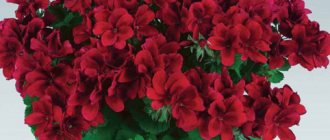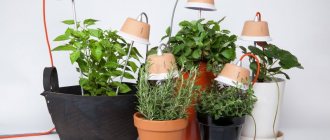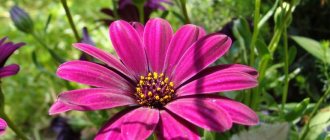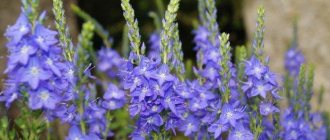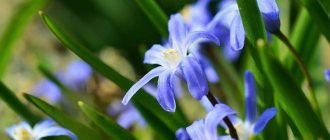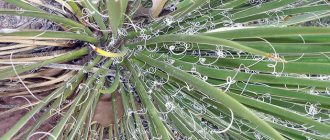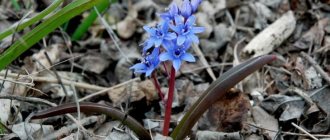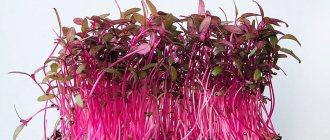Indoor yucca - description
Surprisingly, this beautiful, bright green creature, which lifts your spirits just by looking at it, belongs to the aspargus family. That is, in simple words, asparagus. Unexpected, right?
This is an evergreen plant that can look different (depending on the variety), but always has a trunk and elongated, pointed leaves that grow to form a dense rosette. It grows slowly, but it can easily tolerate dry air, and this is a very valuable quality for an indoor flower, considering that the air in Russian apartments is dried by heating devices most of the year.
The length of the leaves and the height of the false palm itself varies from variety to variety, but on average it grows about a meter in height, and the leaves can reach half a meter in length. Interestingly, they taper towards the end: at the base they usually reach fifteen centimeters, and in the middle they narrow to three to five. The color of the leaves varies from variety to variety, but as a rule they are shades of green interspersed with other colors.
Is Yucca a palm tree or not?
No, not even close, although it is sometimes called an indoor palm or palmita. Indoor yucca just looks vaguely like a palm tree. And so - nothing in common, only a visual similarity, and even that is dubious.
Where does yucca grow - the plant’s homeland
America as a continent. Yucca (not indoor, but wild) is distributed throughout all parts of the continent: in the countries of North, South, and Central America, as well as on the Caribbean islands.
Does indoor yucca bloom at home and how?
Yes, it blooms, and very beautifully: at the bottom of the indoor yucca there is a basket of long horizontally arranged leaves, and the trunk is literally studded with large (up to seven centimeters) white and pink bells.
However, it is very difficult to achieve indoor yucca flowering at home; careful care is required. The main obstacle that prevents indoor yucca from blooming is the lack of light.
How fast it grows
Yucca indoors is a slow-growing creature. For example, if you grow it from a seed or cutting, then only after three years a young but already mature flower will form.
Plant height
Depends on the variety, usually ranges from 50 to 100 centimeters, but there are varieties reaching four meters.
Is Yucca poisonous or not?
No, it is not poisonous, although, of course, you should not eat it for breakfast. Yucca is even used to make medicines.
Flowering plant
How does yucca bloom and when does it happen? It was already noted above that before flowering, the plant throws out a long and thin stem from the center of its bunch of leaves, on which buds and then flowers appear. The inflorescence of a flowering yucca is called a panicle; it consists of a large number of small flowers located at the top of the stem. Typically, the flowers of various types of yucca are white or yellow-white. It is interesting to note that the shape and color of the yucca inflorescence resembles the inflorescences of white acacia.
Yucca blooms only under ideal conditions that are close to its natural habitat. This happens mainly in the summer.
How to care for Yucca at home
Here you will learn how to provide yucca with conditions under which it will feel good and delight you with a healthy appearance. Any disease is easier to prevent than to cure, so it is important to initially create comfortable conditions for indoor yucca, since diseases often develop due to care errors: for example, excessive humidity.
What to do after purchase
After purchasing, you must firstly transplant the green pet into a new pot. This is done because the transport soil does not have the proper amount of nutrients. How the transplant is carried out - read in the corresponding section.
Secondly, you need to quarantine your new green pet, that is, place it separately from the flowers you already have for a week. This is done in order to observe the new pet: whether he brought any infection from the store that could infect the flowers you already have.
Thirdly, you need to choose a place where the indoor yucca will stand and move it there after quarantine. It is advisable to pre-clean this place and wipe off the dust so as not to infect the new tenant through dirt.
Lighting
This is the main difficulty in caring for this unpretentious flower: it needs a lot of light, so choose an eastern or southern room, and in summer you can even put it on a balcony or open ground. In winter, it is appropriate to place yucca under ultraviolet lamps.
Content temperature
Indoor yucca comes from the tropics, so it loves warmth. In summer, the preferred temperature is 25-30 degrees, and in winter it should not fall below +11⁰С.
It is important to avoid drafts, so do not place indoor yucca under an air conditioner or fan, and do not open the windows next to it when it is cold.
Humidity
The flower does not like humidity and often suffers from its excess with fungal diseases. Therefore, it does not need to be sprayed and it is even permissible to place it next to the heating device.
How to water yucca
If the plant is young, then you need to water it every day, but little by little, just to slightly moisten the soil. If the plant is mature, then water it abundantly, but rarely - once every two weeks. In summer – once a week, because it’s hot.
Watering rules:
- Water only when the top layer of soil is dry;
- The water from the pan must be drained after watering, otherwise the roots will rot;
- Make sure that the soil absorbs water and does not remain only on the top layer. If the top layer is wet for several days in a row, loosen the soil so that the water passes down.
In summer
Once a week because it's hot. If the summer is cool and rainy - once every two weeks.
in winter
When cold weather sets in and the temperature does not rise above 18 degrees, watering is reduced to once a month.
Fertilizer and feeding
Required only in summer to support the abundantly growing organism. In summer, nitrogen fertilizing is introduced. There is no need to fertilize in winter, spring, or fall.
Features of watering
Caring for a yucca flower primarily involves proper watering of the plant throughout the year. Since yucca actively grows, sends out new shoots and blooms in the spring-summer period, it is during this period that it is necessary to water it more often (3-4 times a week), however, it is necessary to ensure that the remaining water that passes through the substrate of pots with plants , do not stagnate in pot trays, otherwise this will lead to rotting of the roots of the plant and, as a result, its death.
As the cold season approaches and especially after the yucca blooms, the frequency of watering should be gradually reduced (2-3 times a week). From mid-autumn to early spring, the flower practically stops its growth and prepares for a new flowering period, storing nutrients and gaining strength. Therefore, during this period of the year it should be watered no more than once every 10 days. Here the main criterion is the condition of the soil; as soon as it is almost dry, then it is necessary to water it.
Trimming and shaping
This process is carried out annually. The optimal time is the beginning of spring, when indoor yucca is full of strength and can calmly heal the cuts after the procedure. Autumn-winter is a bad time for pruning, because then the plant’s body is weakened and it may not have enough strength to heal the cuts.
Pruning is carried out for the purpose of aesthetically shaping the plant, to stimulate its growth, and also to obtain shoots for reproduction.
Step-by-step instruction:
- Two days before pruning, water your indoor yucca thoroughly and do not water again until pruning.
- Prepare sharp garden shears or pruning shears, sharpen them properly, and treat them with alcohol. Prepare crushed activated carbon - you will need it to disinfect the cut areas.
- Inspect the flower and cut off excess shoots, holding them by the leaves. The cut is carried out in one motion, the first time, immediately after it is processed with ground coal.
- The main rule: do not allow the stem to break off and always leave at least half a meter, otherwise you will harm the plant, it may even die.
- After pruning, leave the plant in a sunny, warm room, but away from direct sunlight. Watering is reduced to once a month. Fertilizers are introduced (also monthly) to help indoor yucca produce new shoots.
- If you have an indoor yucca with several trunks, then each year you need to prune only one shoot, otherwise the plant will not be able to recover after the procedure.
Some recommendations from flower growers
According to most gardeners, growing a yucca flower is not a difficult task. However, gardeners note that for proper and healthy growth, yucca needs a lot of light and a small amount of water. Since this is a tropical plant, over thousands of years of its evolution it has adapted to the dry period characteristic of low latitudes. Therefore, watering the plant should be done when the substrate in the pot is almost dry.
Flower lovers also note that the long leaves of yucca are quite sharp at the ends, so it is advisable to place the flower out of the reach of children so that they do not get hurt by it.
Yucca Reproduction
In this section you will learn how to plant indoor yucca and get a new, young plant in various ways: from seeds, from cuttings, from lateral shoots or by dividing the bush. Regardless of the method you choose, remember that all operations are carried out exclusively slowly, carefully, carefully, so as not to harm the flower.
If the transplant method you choose uses a knife or scissors, they must be sharp, and before doing anything with them, be sure to wipe the blades with alcohol. This is done in order to cause minimal harm to the plant and not introduce any infection (bacteria may appear on an instrument that has not been disinfected).
All cuts must be made at an angle of forty-five degrees. This is done so that if you take something away from an indoor yucca, it will be easier for it to grow new shoots (leaves, branches) in that place.
Also, regardless of the method, you will need a container where you will transplant the future young flower, and soil.
The soil will need to be loose (to provide oxygen to the root system) and nutritious, since a young growing organism will need more nutrients than an already mature plant. It is recommended to mix the soil from sand, turf, peat and black soil (in equal proportions).
The material of the container does not matter, but it must be equipped with holes to prevent stagnation of water in the ground. The size is still small, since the root system of the plant is still tiny. A large capacity will lead to “fatification,” that is, to the development of the root part instead of the ground part.
Cuttings
Propagation by cuttings is of two types: apical cuttings and stem cuttings. By apical cuttings is the simplest method, suitable for non-professionals, but propagation by stem cuttings is a more complex method.
The ideal time for propagation by cuttings is early spring, when indoor yucca has just woken up and begun to grow.
How to propagate from apical cuttings
How to propagate by tips:
- Cut a rosette of several leaves from the top of the mother plant. It is desirable that there be at least a couple of leaves, or better yet two or three, and that they are healthy, green, and elastic. It is also permissible to take a cutting with a branch, but it should not be too long, just a small piece.
- Leave the cutting to dry for two to three hours, then you need to remove the lower leaves.
- After this, plant it in the ground and cover it with glass or polyethylene. Moderate watering is necessary: so that the soil is always only slightly moist, not allowed to dry out, but nothing more, because excessive watering plus greenhouse conditions create conditions for sprouts to rot.
- The greenhouse is ventilated once a day for ten minutes and condensation is removed from the inside. This is necessary to prevent the cuttings from rotting.
The roots will appear in a month and a half, then you can transplant the cutting into a larger pot, remove the greenhouse and care for it like an adult plant.
You can also carry out cuttings in water. Then you need to immerse the cutting in water in which three or four tablets of activated carbon are dissolved (for disinfection), but otherwise the sequence of actions is the same.
How to propagate from stem cuttings
After trimming the tops, you will be left with a trunk. If it has grown more than twenty-five centimeters, then it can be treated with ground crushed coal and any root growth stimulator, and then cut and planted in nutritious soil.
An important point: you need to plant it the way the trunk grew before, that is, first mark the end of the trunk that was sticking up, otherwise your flower will grow down into the ground and die.
Soon two or three buds will appear. To make them appear faster, you can use a growth stimulator.
After the buds appear, fertilizing is introduced. Fertilizer needs nitrogen, it gives the plant strength to grow.
The future indoor yucca must be placed in a bright place, but not exposed to direct sunlight.
Dividing the bush
Reproduction by dividing a bush is not much different from propagation by cuttings. The only difference: cuttings, as a rule, do not have a root, but when dividing a bush, you can take a shoot so that all parts of the future plant are there: roots, stems, leaves. Such a shoot needs to be transplanted into regular soil for indoor yucca, but with the addition of humus, it will give the young plant more nutrients. Further rules of care are the same as for cuttings.
If you couldn’t separate the bush with its roots, it’s okay: you first need to plant it in coarse sand under a greenhouse so that it takes root. True, this is a slow process: the roots will appear only after a month and a half. After this, the bush is planted in a separate pot and cared for like an adult plant.
It is optimal to divide the bush in August. The mother plant must be large and overgrown so that it does not suffer from the fact that part of the sprouts will be taken from it, but on the contrary, it feels better and is rejuvenated.
Seeds
- Damage the seed coat. Yes, you heard right, it needs to be slightly cut. This is called stratification and helps speed up the growth of the future green pet.
- Place them (don't dig them deep, just lay them) on loose, nutritious soil and cover with polyethylene or glass.
- Provide a suitable temperature (at least 25 degrees).
- Don’t forget to ventilate and wipe away condensation from the greenhouse.
- When the seedling has the first pair of its own leaves, it can be transplanted into a separate pot.
Lateral processes
- Make a cut forty centimeters below the lowest leaves and remove a “belt” of bark from the trunk one and a half centimeters wide at this point. Place a layer of damp moss on the exposed area and cover the top with plastic so that the moss always remains moist.
- After a while, roots form in the moss, and then a lateral shoot. Wait until the roots have grown enough and then cut off the shoot with a sharp tool.
- Do not forget to treat the cut with ground activated carbon in order to immediately kill any possible infection that could remain there after an insufficiently clean instrument, and plant the shoot in the soil for an adult yucca.
Yucca is the tree of happiness. What is it famous for?
This plant received its botanical name three centuries ago from Carl Linnaeus. Yucca visited the Liliaceae family, then she was assigned to the Agave family, and finally she ended up in the Asparagus family, where she remains to this day. In American English, yucca is often pronounced "yakka".
In everyday life, yucca is often called palm tree, dracaena, and cassava. Some types of yucca really resemble a palm tree - a smooth thick trunk is decorated with a rosette of leaves. Dracaena also belongs to the Asparagus family, has an external resemblance to yucca, but it comes from Asia and Africa. But yucca has no relationship or similarity with cassava - confusion arises due to the synonym cassava (yuca, with one letter “k”).
Yucca grows naturally in the southern United States, Mexico and Central America. In Europe, it is cultivated as an ornamental plant in warm regions. Some species can withstand frosts up to 20 degrees.
Blooming yucca Photo: Kurt Stüber, ru.wikipedia.org
The flowering plant is extremely beautiful: flower stalks sometimes grow up to two meters. White or yellowish, greenish-white, cream, bell-shaped flowers are collected in a panicle. They usually open in the evening, filling the air with a rich, bright aroma.
The Yucca genus includes over 20 species, differing in size and stem shape. Yucca can grow as a tree or shrub. Hard, narrow leaves are collected in a rosette. Their length, depending on the type, varies from 30 cm to 1 meter.
Yucca johua grows in the American Mojave Desert; its height reaches 12 meters. It is interesting that when a peduncle appears, the branches abruptly change the direction of growth, giving it space and, probably, wanting to present the flowering in all its glory. The leaves of this yucca are suitable for the production of rope and paper.
There is a romantic legend about the yucca fortress.
...A poor young man fell in love with a girl from a wealthy family. The girl’s father did not agree to the marriage, but wanting to be fair, he gave the guy a test: he handed him a dry stick and said that if it came to life and turned green, he would bless the marriage. The young man stuck a stick into the ground. His love was so strong that tears of despair flowed onto the stick, and it became covered with leaves and bloomed with fragrant white flowers.
...Another legend tells about a tree-like yucca that grew on the sea coast. During a storm, one of the ships lost control. Then the yucca wrapped its strong branches around the ship and held it until the storm subsided. Since then, people have learned about the strength of yucca fibers and began to weave ropes from them.
The indigenous people of the American continent have used yucca for economic purposes since ancient times:
- strong fiber was made from the leaves, which was used to make ropes and bags;
- baskets and mats were woven from dried leaves;
- A red dye was obtained from the roots.
Nowadays, yucca fiber is added to denim for strength. At one time, fabric was made only from yucca leaves, but the demand for denim was great, and there were not enough supplies of raw materials.
Various parts of yucca are used in the pharmaceutical industry to produce medicines.
Yucca Photo: Stan Shebs, ru.wikipedia.org
Astrologers claim that yucca cleanses the room of negative energy and brings health, success and happiness.
Yucca aloe vera is suitable for growing indoors. Its hard, sword-shaped, pale green leaves grow up to 40 cm in length, and as they dry, a palm-shaped trunk is formed. Due to the shape of the leaves, this species is often called the Spanish dagger.
Palm-shaped yuccas look more decorative if they are grown with several tops. To do this, when the plant reaches 50-60 cm, it is necessary to prune. The best time for such a procedure is spring.
The yucca should be watered generously for a couple of days before pruning. Then the top is cut off at a distance of 10 cm from the lower leaves, the cut is dried, and then covered with melted wax or garden varnish.
The cut top is sprinkled with charcoal and used to produce a new plant. To do this, it is placed in wet sand, and after rooting it is transplanted into the ground. In addition, you can propagate yucca with pieces of trunk 10-15 cm long.
Many species reproduce well by daughter rosettes.
Yucca in a flower pot Photo: Ivan Ozherelev, ru.wikipedia.org
, Yucca filamentosa is often grown in open ground . It tolerates frosts well down to 20 degrees or more, even in snowless winters. It has practically no stem, the root system penetrates deeply into the soil, thanks to which yucca can do without watering in the dry months.
The bluish-green leaves, which reach a length of 70 cm, are pubescent along the edges with white, thin, curling threads, which makes the bush unusually attractive. Under favorable conditions, the peduncle of yucca filamentous can reach 2 meters. It blooms with white or yellowish-white fragrant flowers. This species produces many root suckers, which are used for propagation.
Yucca ivory is interesting for growing in apartments and offices .
Yucca gloriousa is popular in decorative floriculture ; it can be grown indoors or in a flower garden. It reaches a height of 1.5 meters. Wide pointed leaves grow up to 70 cm in length.
Yucca is distinguished by its unpretentiousness and resilience. There is enough information on the websites about the technology of its cultivation - there is no point in duplicating it.
From my own experience of growing filamentous yucca in open ground (steppe zone), I can confirm that this wonderful plant can practically do without care. You just need to avoid stagnation of water to prevent rotting of the root system.
What else to read on the topic?
How to grow dracaena? What indoor plants symbolize luck, wealth, love? Bast crops. What are they and where are they used?
Tags: ornamental plants, floriculture, flowering plant
Transplanting Yucca domestica
How to transplant yucca at home, step-by-step instructions:
- Wash the pot you will be planting in thoroughly with hot water and soap.
- Place two to three centimeters of expanded clay on the bottom and partially fill it with soil mixture (approximately to the middle of the pot).
- Treat the soil mixture with a fungicide, as indoor yucca suffers from soil-borne fungal diseases.
- Carefully remove the yucca from the previous pot. Taking this opportunity, be sure to inspect the roots: have they begun to rot? If this is the case, then cut off the rotten parts with sharp scissors and sprinkle the sections with ground activated carbon.
- Place the plant in a new pot and fill in the remaining soil so that there are no air spaces. Lightly tamp down near the trunk.
- Water the plant generously (if there was no root rot, if there was, then watering is not recommended for the next two to three days).
When can you replant?
Transplantation is carried out either in emergency cases (for example, if the plant is infected with pests or fungi), or it is a planned transplant due to the growth of indoor yucca. Such a transplant is carried out every two to three years if the plant is mature (over five years old) or annually if the plant is young and developing quickly. With each transplant, the pot grows a little.
The optimal time of year for transplantation is early spring.
Priming
The composition of the soil includes peat, turf and coarse sand in a one to one ratio. If the plant is young, then it would be appropriate to add humus. Also don’t forget a two to three centimeter layer of expanded clay (can be made from crushed brick). If you decide to buy ready-made soil for indoor yucca, then peaty, neutral acidity will do.
What kind of pot is needed for yucca
When replanting, a pot for yucca is of great importance. Its size is calculated as follows: proceed from the idea that the pot should be three to four larger in scope than the root ball of the plant. And its height should be two to two and a half times greater than the diameter.
That is, conditionally: if the diameter of the yucca root ball is fifteen centimeters, then the diameter of the pot is nineteen, and the height or depth is thirty centimeters (all numbers are taken conditionally to demonstrate the principle).
The material of the pot is not so important, but it must be resistant to damage and heavy enough so that the tall, branched, tree-like yucca does not accidentally outweigh it.
Curious facts about yucca
At the end of the article, we provide interesting information about this plant:
- In the western United States, this flower is called the “ghost of cemeteries” because it grows in large quantities in rural cemeteries, and when it blooms, the white inflorescences swaying on a thin, tall stem in the wind give the impression of ghosts.
- In South America and the Caribbean, a food product called casabé is made from flour obtained from the roots of the plant. This is thin unleavened bread that practically does not spoil for a long time. Making casabé is an exclusively Indian tradition, but currently in countries such as Venezuela, Colombia and some others, small commercial firms are engaged in the production of casabé. There are two types of yucca flower roots: sweet and bitter. The latter contains cyanide compounds and is poisonous. It is curious, but it is from the bitter root that casbe is made, having previously squeezed out all the poisonous liquid from it.
Diseases and pests of Yucca and their treatment
In this section we will talk about the most common problems associated with diseases and pests of indoor yucca.
Diseases
- Cercospora blight.
Symptoms: light brown spots with a dark outline on the leaves. The spots gradually increase in size and then merge together.
Why did this happen: as a rule, this disease is caused by waterlogging of indoor yucca: excessive watering, spraying.
What to do: cut off damaged shoots, treat the cuts with a solution of potassium permanganate, and then treat the entire plant with a fungicide two to three times at intervals of ten days.
- Brown spotting.
Symptoms: at the initial stages of the development of the disease, light spots appear on the lower leaves of indoor yucca. The light spot turns yellow, and then the leaf dries out and turns brown. Small dark growths are noticeable on the spots - this is the fungus that brought the brown spot with it and is spreading further.
Why this happened: waterlogging of the soil.
What to do: remove damaged shoots as soon as possible and treat with potent fungicides.
- Fusarium rot.
Symptoms: the danger of this disease is due to the fact that it is invisible in the early stages. Visually it becomes noticeable when it has already developed strongly: you will see the bases of the leaves rotting.
Reason: like any rot, fusarium rot appears due to waterlogging of the plant.
What to do: treat with fungicides several times at intervals of ten days; if that doesn’t help, destroy the plant. In this case, the soil for indoor yucca and the pot are also destroyed, since from there the fungus that carries the disease can spread to other plants.
- Leaf necrosis.
Symptoms: gray spots on the edges of leaves, sometimes wet.
What to do: remove the damaged shoots entirely or at least their damaged parts, sprinkle the sections with ground activated carbon (for disinfection, so that no other infection penetrates into the plant through the damaged, tender place), then treat with a fungicide.
- Stem rot.
Symptoms: darkening of the trunk, then a soft trunk of the yucca, ulcers oozing something liquid appear on it. One of the most dangerous diseases for indoor yucca often leads to the death of the plant.
What to do: carefully cut off the damaged part of the trunk. The cut is made with a sharp, disinfected instrument two to three centimeters above the damaged part. The cut part is destroyed (for example, burned). The cut is treated with a fungicide and then sprinkled with ground activated carbon. In this case, the soil for indoor yucca also needs to be treated with a fungicide.
- Root rot.
Symptoms: the complexity of this indoor yucca disease is that it is difficult to notice from the outside, since it affects the roots; often owners notice root rot only when replanting the plant, when they notice that the roots have darkened and become soft. From the outside, root rot is manifested by slow growth, yellowing and wilting of leaves.
What to do: if the lesion has not yet managed to capture most of the root system, it is necessary to cut off the diseased roots and sprinkle the sections with ground activated carbon. Then you need to transplant the indoor yucca into a pot where the soil has been treated with a fungicide, and do not water it for some time after transplantation until it takes root. If the root rot has spread greatly, the plant will have to be destroyed.
Pests
- Shield.
Symptoms: Hard, raised, clearly visible growths on the leaves, followed by sticky droplets. If nothing is done about this, then, firstly, indoor yucca will not receive enough nutrients, since some of its juices are drunk by the scale insect, and secondly, in the sticky and moist environment created by its waste products, fungus easily develops.
What to do: treat the plant with a soft cloth or cotton wool soaked in a soap or alcohol solution, treat the soil with an insecticide (three times with an interval of ten days).
- Spider mite.
Symptoms: the leaves first lighten, then a white coating and a thin cobweb appear on them.
What to do: treat with an insecticide and then spray with a soap solution or garlic decoction.
- Mealybug.
Symptoms: clumpy, cotton-like patches, general limp, yellowed appearance of the plant.
What to do: wash with soapy water to wash away all existing parasites, then treat the plant with an insecticide four times at weekly intervals.
- Aphid.
Symptoms: You will notice the insects themselves (tiny bugs: green, clear or brown) at the bases of the leaves. Aphids drink the juices of the plant and secrete a sticky substance in which the fungus readily develops.
What to do: spray with soapy water and then treat with insecticides. Treatment must be started immediately: aphids are very voracious.
Diseases
The main indicator that something is wrong with the plant is the leaves. Any change in their color and shape should alert you. Yucca indoors tolerates diseases quite easily, it is only important to know their symptoms so as not to cause damage.
- If you notice that the yucca leaves are suddenly covered with large brown spots, this is evidence that a fungus has settled on them, caused by waterlogging of the soil or air. Diseased leaves must be removed to prevent the fungus from spreading. After this, you immediately need to change the plant’s place of residence, moving it to a drier part of the apartment, and stop spraying the air around it.
- A more serious type of fungal infection is stem rotting. This is again due to waterlogging and lack of fresh air. After taking the measures described in the previous paragraph, a partially diseased plant can still be saved by cleaning the festering areas of the stem. If the rotting process cannot be stopped, the palm tree should be disposed of along with the pot so that the disease does not spread to other house plants.
As you already understand, yucca is not particularly capricious, is extremely unpretentious and, with proper care, is practically not susceptible to diseases.
Popular varieties of indoor Yucca with photo and name
It would seem that yucca is a plant that does not imply diversity of species. But still it exists, albeit not very numerous.
Elephant (Elephantis, Elephantipes)
One of the largest varieties, can reach several meters in height. Multi-stemmed variety, the trunk is thick and tree-like. Very reminiscent of a palm tree.
Gray
It blooms more readily than others even at home, as well as by the shape of the bush (perfectly round, made of thin, militantly protruding shoots) and cold dark green color.
Glorious
Very similar to the previous one, but the leaves are slightly wider and also decorated with a thin light border along the contour. The color is very beautiful, similar to the color of spruce needles.
Aloifolia
The name matches the content: thanks to the bright green, rich color and shape of the bush, this variety really resembles aloe.
Variegated
Quite wide leaves taper towards the end, the bush is round, low, rather tends to grow horizontally. Leaves with a light underside and edge.
Rostrata
An interesting variety that you don’t immediately recognize as a yucca: single-stemmed, with a thick, long trunk and a semicircular cap of thin blue-green shoots.
Coracoid
The variety is very similar to the previous one, but much smaller and lower, but the bush, on the contrary, is more luxuriant, and the blue tint of the foliage is more pronounced.
Copstack
A modest variety that is well suited for decorating offices: not too tall (70 cm), with a small number of slightly rounded leaves growing in a rosette.
filamentous
One of the most common varieties. It blooms more readily than others, blooms magnificently and beautifully. If it does not bloom, it pleases with the rich blue-green hue of the leaves.
Possible problems and difficulties in care
If you spray or water too often, the leaves and stem will begin to rot and brown, ugly spots will appear on the surface. Try to immediately remove diseased leaves, reduce the amount of moisture and treat the plant with a special preparation. In addition, do not forget to move the yucca to another pot, adding fresh soil - this will save your green beauty.
- Shedding leaves - this happens most often after transplantation. The plant is very capricious and painful when transplanting into another pot, which is why transshipment is often done. After transplantation, create the favorable conditions described above. A common reason: draft or daily temperature changes.
- Leaves turn yellow and fall off - this happens for several reasons, mainly watering and temperature conditions are disturbed. Overwatering is very dangerous for the flower. During the growing season, the temperature should not fall below 18-20 degrees.
- The leaves turn pale, droop, the trunk stretches out - there is not enough lighting, change the place.
- The edges of the sheet plastic are brown - most likely it is sunburn. Occurs in young plants.
- The leaves wither, the trunk bends - an excess of moisture has led to rotting of the roots. Immediately replant in dry soil, after cutting off the rotting roots. Often the yucca cannot be saved. You can cut off the top, place it in water until the roots appear and after 1-2 months root it in the ground.
- Dark leaf tips indicate low humidity or insufficient watering.
- Curling leaves - insufficient or too much watering. Water the plant after the top layer of soil has dried.
- Fungal diseases have appeared - this happens for several reasons: an excess of fertilizers (nitrogen), abundant watering, high humidity, low temperatures in the summer; during hibernation, low temperatures are accompanied by abundant watering.
- Yucca does not bloom - often the plant does not bloom at home. To see beautiful white bells, you need to keep the conditions as close as possible to the natural environment.
What the Yucca palm tree brings to the house: signs and superstitions
How is indoor yucca useful from the point of view of physiology and strict evidence-based science? Indoor yucca is, first of all, an excellent oxygen generator.
Large plant with large green leaves. It grows, goes about its legitimate business - photosynthesis - during which it absorbs carbon dioxide and produces oxygen instead. Thanks to this, the air in the room is purified, it becomes easier to breathe, and accordingly, the inhabitants of this room think better, sleep more peacefully, and their overall well-being and mood improve, because the level and quality of oxygen in the blood affects the condition of the entire body.
And from the point of view of bioenergy, signs, and various philosophies, the following interesting facts are associated with yucca:
- It is believed that indoor yucca has a positive effect on the energy in the house. It prevents conflicts between family members, helps to make informed decisions, and feel calmer and more confident. From a scientific point of view, this effect can actually be achieved by improving the quality of oxygen in the house, and consequently, mental abilities.
- It is also believed that indoor yucca attracts good luck, positive energy, and material well-being.
- A beautiful and sad legend is associated with indoor yucca: supposedly the first yucca in the world appeared because it was abundantly watered with tears by a passionately in love young man who could not be with his beloved. Therefore, it is believed that indoor yucca strengthens marriage and prevents adultery.
- According to the philosophy of Feng Shui, plants such as indoor yucca are best placed in offices, rooms where people work, negotiate, and engage in creative work, since indoor yucca clarifies thoughts, calms, helps to concentrate, and reason about difficult situations sensibly and balancedly .
- They say that if you bury a few coins in a pot of indoor yucca, this will attract material wealth to your home.
- But there are also negative superstitions: for example, it is believed that you should not refuse someone who asks you for a branch of indoor yucca to grow his own yucca. This plant does not like greedy people; it generously gives away its energy to everyone around it and will attract failure to the owner who interferes with it. It is also believed that an unmarried person should not grow indoor yucca: the energy of the plant scares off potential spouses.
- According to Feng Shui, before choosing a plant, you need to look at its leaves. If they have a pointed shape, it means that this plant carries with it Yang energy, it will motivate achievements, stimulate action. If the leaves are round, then this is a plant with Yin energy - it will calm, pacify, promote the thought process, and immersion in oneself.

